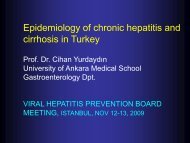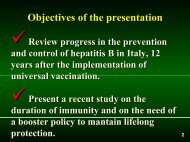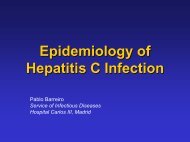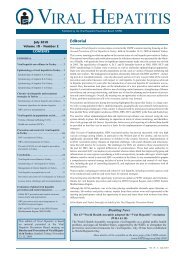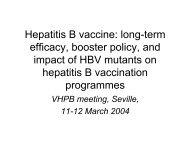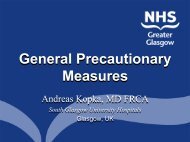Prevention and control of perinatal hepatitis B virus transmission in ...
Prevention and control of perinatal hepatitis B virus transmission in ...
Prevention and control of perinatal hepatitis B virus transmission in ...
You also want an ePaper? Increase the reach of your titles
YUMPU automatically turns print PDFs into web optimized ePapers that Google loves.
HBV-endemic areas, PT <strong>in</strong>fants, irrespective <strong>of</strong> their birthweights, may benefit from an additionaldose <strong>of</strong> <strong>hepatitis</strong> B vacc<strong>in</strong>e <strong>in</strong> a schedule start<strong>in</strong>g at birth. This approach will prevent vertical<strong>transmission</strong> <strong>and</strong> br<strong>in</strong>g their immune response up to par with term <strong>in</strong>fants. Term <strong>in</strong>trauter<strong>in</strong>egrowth-retarded <strong>in</strong>fants should be vacc<strong>in</strong>ated as per the schedule recommended for normal term<strong>in</strong>fants. However, studies <strong>in</strong> other sett<strong>in</strong>gs with different vacc<strong>in</strong>e formulations <strong>and</strong> a longer followupperiod will be required before this strategy can be practised more widely.Asratian AA, Melik-Andreasian GG, Mkhitarian IL, Aleksanian IuT, Shmavonian MV,Kazarian SM, Mkhitarian RG, Kozhevnikova LK. Seroepidemiological characterization <strong>of</strong><strong>virus</strong> <strong>hepatitis</strong> <strong>in</strong> the Republic <strong>of</strong> Armenia. Zh Mikrobiol Epidemiol Immunobiol 2005; 5:93-96.[Article <strong>in</strong> Russian]The survey <strong>of</strong> the population immunological structure with respect to parenteral <strong>hepatitis</strong> showedawide circulation <strong>of</strong> <strong>hepatitis</strong> B (HB) <strong>and</strong> <strong>hepatitis</strong> C (HC) <strong>virus</strong>es among the adult population <strong>of</strong>Armenia. Dur<strong>in</strong>g the 5 year period <strong>of</strong> observation the number <strong>of</strong> persons hav<strong>in</strong>g antibodies to HC<strong>virus</strong> <strong>in</strong>creased 2.7-fold. High occurrence <strong>of</strong> antibodies to HBsAg <strong>of</strong> HB <strong>virus</strong> among the healthypopulation <strong>in</strong> 2002 (12.0%) <strong>in</strong> comparison with 1997 (5.4%) reflected a decreased <strong>in</strong>fection ratewith HB <strong>virus</strong> as well. Antibodies to <strong>hepatitis</strong> A (HA) <strong>virus</strong> were isolated, on the average, <strong>in</strong> 64 %<strong>of</strong> persons. Simultaneously with a decrease <strong>in</strong> the proportion <strong>of</strong> HA cases an <strong>in</strong>creased number <strong>of</strong>HC patients was registered. No circulation <strong>of</strong> <strong>hepatitis</strong> E <strong>virus</strong> was detected. A high percentage <strong>of</strong><strong>hepatitis</strong> cases <strong>of</strong> mixed etiology was established, as well as an <strong>in</strong>creased number <strong>of</strong> comb<strong>in</strong>edparenteral <strong>hepatitis</strong> cases was registered (57.1%).Asratian AA, Isaeva OV, Mikhailov MI. Tendency <strong>and</strong> analysis <strong>of</strong> the epidemic situation <strong>in</strong>parenteral <strong>virus</strong> <strong>hepatitis</strong> B <strong>and</strong> C <strong>in</strong> the Russian Federation <strong>and</strong> a number <strong>of</strong> its regions. ZhMikrobiol Epidemiol Immunobiol 2005; 4:40-45. [Article <strong>in</strong> Russian]As revealed <strong>in</strong> the present survey, dur<strong>in</strong>g the last 3 years, aga<strong>in</strong>st a background <strong>of</strong> decreasednumber <strong>of</strong> registered cases <strong>of</strong> acute <strong>hepatitis</strong> B (HB) <strong>and</strong> acute <strong>hepatitis</strong> C (HC), an <strong>in</strong>crease <strong>in</strong> theproportion <strong>of</strong> patients with the chronic forms <strong>of</strong> these diseases was observed. The <strong>in</strong>cidence rate <strong>of</strong>carriership <strong>of</strong> <strong>hepatitis</strong> B (HBV) <strong>and</strong> <strong>hepatitis</strong> C <strong>virus</strong>es (HCV) is many times greater thanmorbidity rates <strong>in</strong> acute <strong>and</strong> chronic forms <strong>of</strong> the disease. Such differences could be due toimperfect laboratory <strong>and</strong> cl<strong>in</strong>ical diagnosis. The registered statistics on HBV <strong>and</strong> HCV carriership<strong>in</strong>cluded newly detected HBsAg <strong>and</strong> anti-HCV <strong>in</strong> the absence <strong>of</strong> cl<strong>in</strong>ical manifestations, which didnot reflect the true spread <strong>of</strong> HBV <strong>and</strong> HCV <strong>in</strong> a given territory. The group <strong>of</strong> HBV <strong>and</strong> HCVcarriers was found to <strong>in</strong>clude a considerable proportion <strong>of</strong> patients with asymptomatic form <strong>of</strong> HB<strong>and</strong> HC. It was test<strong>in</strong>g for HBsAg, anti-HCV only without determ<strong>in</strong>ation <strong>of</strong> <strong>virus</strong> replicationmarkers (anti-HBc IgM, HBV DNA, anti-HCV IgM, HCV RNA) that seem<strong>in</strong>gly determ<strong>in</strong>ed thecategory <strong>of</strong> carriers greatly exceed<strong>in</strong>g the true <strong>in</strong>cidence. To obta<strong>in</strong> reliable epidemiological<strong>in</strong>formation, the complex detection <strong>of</strong> HB <strong>and</strong> HC <strong>in</strong>fection markers is necessary.Balan A, Beldescu N, Popa R. The prevalence <strong>of</strong> viral <strong>hepatitis</strong> B <strong>in</strong> pregnant women <strong>in</strong> an area<strong>of</strong> southern Romania. Bacteriol Virusol Parazitol Epidemiol 1998; 43:254-260. [Article <strong>in</strong>Romanian]Institutul de Sanatate Publica Bucuresti.In Romania, the acute <strong>hepatitis</strong> B <strong>virus</strong> (HBV) <strong>in</strong>fections are considered to be a public healthproblem. One <strong>of</strong> the most effective routes <strong>of</strong> <strong>transmission</strong> is from <strong>in</strong>fected mothers to newbornsboth <strong>per<strong>in</strong>atal</strong> <strong>and</strong> <strong>in</strong> early childhood. That for, this study objective was to estimate the prevalence<strong>of</strong> <strong>hepatitis</strong> B <strong>in</strong> pregnant women. We used the cluster sampl<strong>in</strong>g method with a sample size <strong>of</strong>1356 pregnant women. F<strong>in</strong>ally our study was based on 1298 blood samples com<strong>in</strong>g from 196





